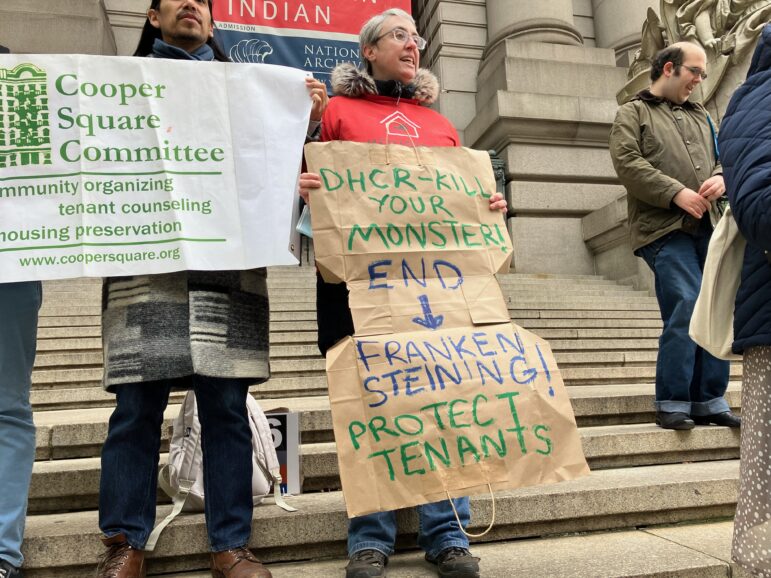“A crucial part of solving the housing crisis is retaining the rent-stabilized housing stock that exists. By signing S2980, S2943, S1684 and S995, Gov. Hochul would keep more rent stabilized apartments available at honest rents by landlords known to their tenants, and enable more municipalities to decide whether they want the same.”

Emma Whitford
Tenants rallied in November ahead of a meeting on rent regulations in Lower Manhattan.Finding affordable rental housing is a huge hurdle—that’s not news to New Yorkers. In New York City alone, according to a recent New York Times report, over 100,000 people are in homeless shelters. At the same time, the city is losing affordable housing every day.
Everyone’s got a sweeping proposal to ease the housing crisis in New York. But four bills now awaiting the governor’s signature may make a big difference in keeping existing affordable housing available. As a group concerned with tenant safety and the warehousing of empty, affordable apartments, we look to Gov. Kathy Hochul to quickly sign them.
One bill would keep rent-stabilized apartments combined with other space more affordable and under rent regulation. New York State’s housing agency passed helpful regulations on this—but a statute is always stronger!
Another bill would empower tenants to address rent overcharge fraud that occurred prior to the landmark Housing Stability and Tenant Protection Act of 2019. The third would provide guidance on whether rent stabilization applies in upstate localities that want it, and the fourth would clarify who really owns a building—and who’s responsible for maintenance.
All four bills implement the intent of the landmark 2019 tenant law, the Housing Stability and Tenant Protection Act.
The governor has only until Dec. 31 to act on these bills, while delay gives owners time to take more warehoused rent-stabilized apartments out of affordability and combine them into new, Frankensteined apartments beyond the financial means of most New Yorkers. Our group’s Warehousing and Frankensteining Report found at least 71 units lost to affordability through Frankensteining—and that’s just in three case studies.
Delay also keeps municipalities from figuring out the actual number of vacancies—and whether their tenants have a right to rent stabilization. It keeps the fog around how overcharges should really be calculated and keeps tenants from knowing which people own their building and are responsible for repairs.
On the local level, the NYC Council should pass Councilmember Carlina Rivera’s Intro. 195-B, which would prompt city inspections of unoccupied apartments—including those being held empty by owners looking to Frankenstein them—if conditions in the vacant unit pose a hazard to neighbors.
A crucial part of solving the housing crisis is retaining the rent-stabilized housing stock that exists. By signing S2980, S2943, S1684 and S995, Gov. Hochul would keep more rent stabilized apartments available at honest rents by landlords known to their tenants, and enable more municipalities to decide whether they want the same. Please urge her to sign them pronto.
Sue Susman is a rent stabilized tenant and president of the Central Park Gardens Tenants’ Association, part of Stellar Tenants for Affordable Housing. She also runs an email list on affordable housing, aff-hous@googlegroups.com.
Edward Ratliff is a long-time tenant in a Kips Bay building that has lost numerous affordable apartments to Frankensteining and is a member of the Coalition to End Apartment Warehousing.









One thought on “Opinion: Four Bills Awaiting Hochul’s Signature Would Ease NY’s Housing Crisis”
Tbh I don’t think anyone should get 2 have rent stabilized unless they can offer it 2 the majority. Y should a select few get such a huge perk, while tje rest of us r told 2 F off if we can’t afford it. What makes them so special anyway? We talk about equality but never about all the double standards thst make things un equal. Not just the laws we live by on paper but the unwritten rules like 4 ex) y do pretty people automatically get 2 cut the line. It’s bs but nobody says anything we just let it happen. Entitlement is always wrong no matter who’s benefitting.